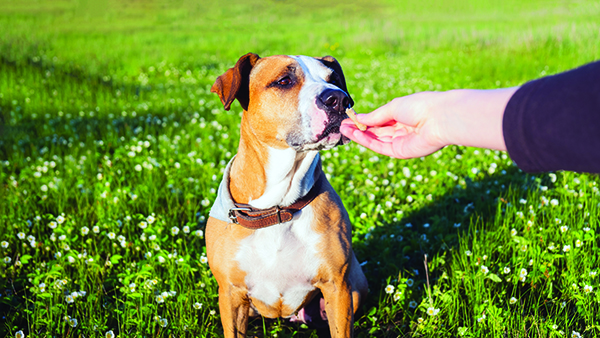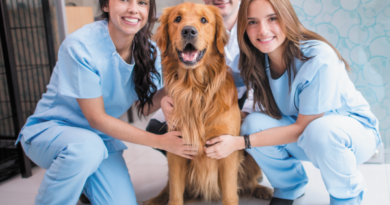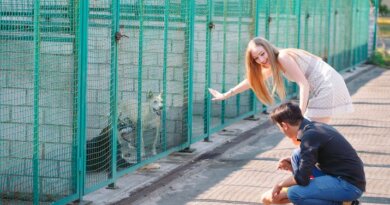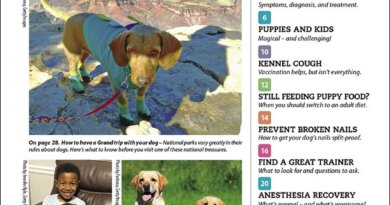Positive Reinforcement Training Without Treats

I use treats when I train. So do my clients. Now that positive reinforcement training has a 25-year-plus track record in the dog world (supported by studies that affirm its effectiveness), the use of treats in training has become widely accepted and embraced.
There are times, however, when you can’t use treats. Perhaps your dog isn’t particularly motivated by food. Maybe there’s a medical reason your dog can’t have food right now. Or perhaps (horrors!) you ran out of treats. The good news is that food isn’t the only form of reinforcement we can use in training – there are a number of others ways you can reinforce your dog’s behavior.
NOT FOOD MOTIVATED?
The fact is, all dogs must be food motivated, at least to some degree, or they truly will starve. We all have to eat to live.
But it’s true: Some dogs are more interested in food than others: Labrador Retrievers are notorious for being “food hounds.” In fact, a recent study found this breed is more likely to have a very strong interest in food because they have a specific gene mutation associated with food obsession. (Flat-coated Retrievers have it too, but it has not been found in any other breeds.) Still, all dogs must eat, so the first questions we need to ask are:
* Why is my dog not more interested in training treats?
* Are there things I can do to increase my dog’s interest in training treats?
* If I can’t get him to be more interested in treats, or if he can’t have treats right now for some reason, or if, inexplicably, I ran out, are there other reinforcers I can use in my training program?
There are several reasons why your dog might not appear to be motivated by food during training:
* Medical causes. We always want to consider and rule out or treat any possible medical causes for or contributors to a behavioral challenge, including anorexia. If your dog truly has little to no interest in food, if you have not already, please discuss this with your veterinarian as soon as possible. There is a long list of possible medical reasons why your dog may not be interested in food, and some of them are very serious.
* Treats are low in value to your dog. Perhaps you’ve heard the suggestion to use your dog’s regular kibble for training. This could well work for a Lab and for other very food-focused dogs, but for dogs who aren’t as interested in food, kibble just might be too boring.
* Easily bored with your high-value treat. Some dogs get bored with (or just too full to be very interested in) a great number of the same delicious treat. Be prepared with a list of treats your dog considers high-value, and when her interest in one starts to wane, switch to another.
Most dogs love chicken (baked, boiled, or thawed-out frozen chicken strips), and yet we often see dogs tire of it at our academies, where they are plied with training treats throughout the day. Other treats dogs tend to love include roast beef, cheese, cooked hamburger, meatballs, peanut butter squirted from a tube, ham, baby food – the list is endless. If your dog is less than enthusiastic about food, the longer your list of potential high-value treats needs to be.
*Your dog is easily distracted, or the environment holds too many or too highly disturbing distractions. If your dog is on the mild-to-moderate end of the food-interest continuum, environmental distractions can serve to deflect her desire for treats, especially if she is easily distractible, and/or if you haven’t done your homework to generalize her behaviors to a variety of different locations. If this is the case with your dog, try higher-value treats and/or do more training in a less distracting environment before generalizing to more distractions. (Your backyard might seem perfect – but not when there are squirrels racing around the trees, or the neighbor’s dogs are barking at you through the fence.)
* Your dog is not hungry. This is a concept totally foreign to your average Labrador, but a lot of dogs who are not as crazy about food as the Lab will be less enthusiastic about working for treats if they just finished a meal. This is an easy fix: Schedule your training sessions before mealtimes, not after, and don’t feed your dog just before training class.
* Your dog is stressed. This is one of the most commonly overlooked reasons for dogs to turn up their noses at their training treats. It is biologically appropriate, for survival reasons, for her appetite to shut down when your dog is stressed. When the brain signals “danger,” the last thing an organism should do – if they want to survive – is stop for a bite of food, so the part of the brain that controls appetite turns off until the danger is over.
If your dog is reluctant to take treats because she is stressed, you may be able to tempt her with higher-value treats, but the best solution is to figure out how to make the stress go away – or at least decrease enough so she can happily eat again. (If she can normally take a treat gently, but in a stressful situation goes from not taking the treats to blindly grabbing at the food, sometimes getting your fingers in the process, her stress level is still too high for effective learning; move farther from the stressor.)
Sometimes a dog will learn to take treats in the face of her stressor just through habituation (she just gets used to it), although a concerted effort at counter-conditioning and desensitizing her to the stressor tends to be more effective and faster. (See “Counter-Conditioning and Desensitization,” WDJ March 2020.)
In some cases, if the dog’s stress levels are persistent, behavior modification drugs are in order. This calls for another discussion with your vet. If your veterinarian is not behaviorally knowledgeable, she can schedule a phone consult with a veterinary behaviorist for assistance in determining what medication(s) might be appropriate for your dog. Your vet can find a list of Certified Veterinary Behaviorists at dacvb.org/search.
OTHER REINFORCERS
One of the great things about using food as a reinforcer in training is that the dog can eat the treat quickly and immediately go on to the next behavior. But anything your dog perceives as “good stuff” can theoretically be used as a reinforcer. Play, for example, is an excellent, very strong “other” reinforcer for many (but not all) dogs. Keep in mind, however, that other reinforcers can take more time to deliver and regroup from, and thereby are more likely to interrupt the flow of training.
Now that the use of food in training has become so widespread, it’s easy to forget that there are a multitude of other ways to reinforce your dog’s behavior.
The definition of a reinforcer is “something that causes a behavior to increase.” In positive reinforcement training we teach our dogs that certain behaviors make “good things” (reinforcers) happen, so our dogs learn to offer those behaviors in order to make good stuff happen.
Food is what we call a primary reinforcer, meaning it has innate value to the dog. Dogs don’t have to learn to like food; they are born looking for their mother’s milk. A scratch under the chin feels good – it has innate value – so that’s another primary reinforcer.
Verbal praise, however, is a secondary reinforcer; it takes on value through its association with a primary reinforcer such as food treats, excitement, and scratches under the chin. Toys, too, are secondary reinforcers; they take on value through their association with the predatory chase response. (Doubt this? Have you never met a dog who was initially mystified and uninterested in toys, but learned to play with them over time?)
HOW TO USE A NON-FOOD REINFORCER
If you want to (or have to) make use of reinforcers other than food in your training, start by making a list of all the other things your dog loves. Here are some potential non-food reinforcers:
• Tennis balls, or balls with a pleasing squishy texture
• Squeaky toys
• Playing tug
• Playing “chase me” games
• Going for a ride in the car (a chief pleasure for some dogs, aversive for others; know your dog!)
• Leash walks
• Off-leash hikes
• Swimming (again, it’s important to know your dog; some hate water!)
• Sniffing
• Performing a favorite trick for an appreciative audience
For each item on this list, write down how you might be able to use that as a reinforcer in your training program. Some are easier than others. Here are some examples:
* Use sniffing to reinforce your dog’s polite leash walking. Have your dog walk politely with you for a reasonable stretch (short enough that she can succeed!), then give her a release cue and say, “Go sniff!” (This works especially well at first if you give her the “Go sniff” cue when you know you are near something that she would like to sniff.)
*Use tug to reinforce your dog’s “Stay.” Have your dog stay for whatever length of time she is able (set her up to succeed!), return to your dog, mark her for staying, give your release cue, then invite her to tug.
Remember to pause various lengths of time before your release cue, so she doesn’t start anticipating the release. You can even remind her to stay, hold up the tug, put it behind your back and hold it up again, several times, so the mere sight of the tug toy doesn’t become the cue to release from the stay. This, by the way, is a great impulse-control exercise.
* Use a squeaky toy to lure and reinforce sits and downs. To lure a sit, hold the toy over your dog’s head the way you would a treat, and when she sits, squeak and toss the toy. To lure a down, slowly move the toy toward the ground and, when she lies down, squeak and toss. If that doesn’t work, move the toy under your knee or a stool, so she lies down to crawl after the toy. When she does, squeak and toss.
* Use a tennis ball to reinforce your dog’s recall. She comes when you call, you mark her for coming, and then throw the ball for her to chase. If she’s one of those who won’t bring it back, have several balls within reach so you can call her back and toss the next ball when she comes. If you want her to sit in front of you as part of your recall, wait for her to sit before you mark and throw.
Now take your own list of reinforcers and write down scenarios that incorporate them into your training program. You will likely find some reinforcers that are impractical for training (say, the dog who loves to roll in deer poop), but you should end up with a treasure trove of possibilities!
If there are secondary reinforcers you would like to use that your dog isn’t already enthusiastic about, you can “charge” them by associating with something your dog already loves. If you want your dog to be happier about your verbal praise, repeatedly praise her and then throw her beloved ball, so she begins to associate praise with the joy of chasing a squeaky ball. If she’s not crazy about car rides, start taking short car rides that always end up at someplace wonderful (such as the swimming hole, if she loves swimming).
You get the idea. Whether your dog won’t take or can’t have treats, if you look for and create a good long list of other high-value options, you will always be prepared to reinforce your dog for appropriate and desired behaviors. She will love you even more for that.







